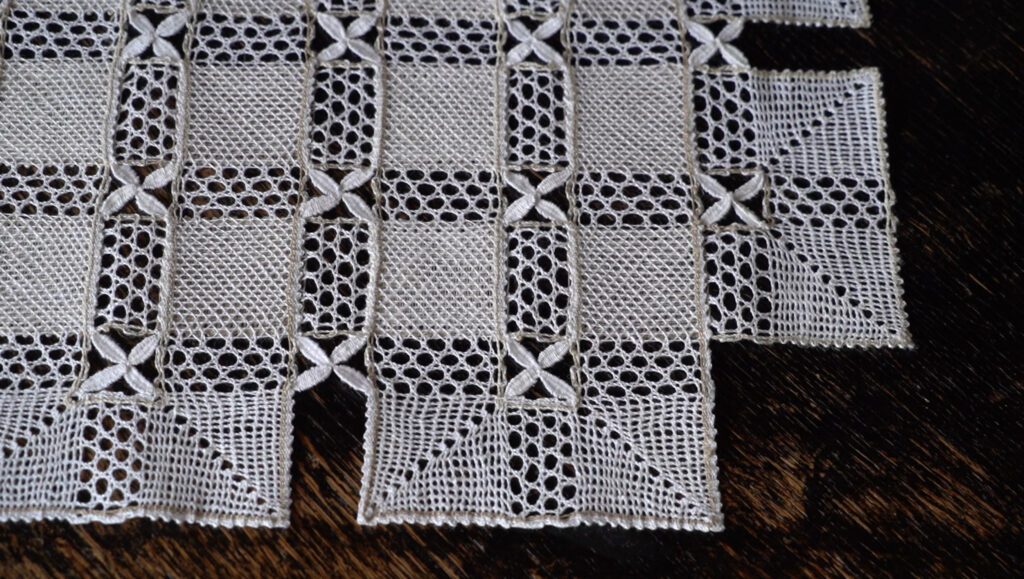Her family comes from Špania Dolina, and that's why she encountered bobbin lace making as something natural from a very young age. Her role model was her grandmother and later her mother. Her sister also makes bobbin lace and even her father, originally from Prague, who learned this craft after marrying into the lace-making bastion that Špania Dolina undoubtedly is....
Her family comes from Špania Dolina, and that’s why she encountered bobbin lace making as something natural from a very young age. Her role model was her grandmother and later her mother. Her sister also makes bobbin lace and even her father, originally from Prague, who learned this craft after marrying into the lace-making bastion that Špania Dolina undoubtedly is. Although he didn’t actively make lace, he mastered the lace-making technique and helped his daughter determine her direction in lace making. Under his influence, she focused on creating artistic pieces, not utilitarian ones, and their first artwork was created together when she realized her father’s artistic design.
Soňa Bezúchová studied at the Secondary School of Applied Arts in Kremnica, specializing in flat and relief metal engraving, and also toyed with the idea of studying textile arts at university. However, she ultimately decided to pursue lace making as a hobby from the beginning. As the inheritor of the Špania Dolina lace-making tradition, she had good material equipment from the start. For example, she inherited bobbins from her grandmother, and over the years, others added more bobbins from people who wanted to try making lace but didn’t stick with it. Similarly, she inherited many threads from older women who had already retired from working with them. She even made her own lace pillow filled with sawdust.
In her own creations, she goes beyond regional styles of bobbin lace and draws inspiration from her surroundings, creating her own patterns. Naturally, she was also subconsciously inspired by the lace she saw around her, but to this day, she doesn’t specialize in any particular regional type. She approaches lace making intuitively, combining what she likes. Perhaps this approach was characteristic of bobbin lace even in the vibrant traditional environment of the past. As she says, in the Špania Dolina lace, which is even older than her grandmother’s work, she sees various regional styles, which could prove that women were always primarily inspired by what they liked. And if the community embraced it, it became part of the local tradition.
Her collection mainly consists of artworks. She started making utilitarian items only after establishing cooperation with the ÚĽUV (Center for Folk Art Production), which began in the Regional Crafts Center in Banská Bystrica in 2007. Here, prompted by the graduates of the first bobbin lace courses she led, she also founded a bobbin lace club in 2010. It was here where she began to devise themes that leaned towards utility (e.g., Easter eggs, pillows, etc.). She also participated twice in the “Kruhy na vode” competition, showcasing utilitarian pieces there as well (tablecloths, bags). However, as already mentioned, she felt most comfortable from the beginning of her creative journey with bobbin lace pictures, often of larger dimensions.
Each picture stems from her imagination. She doesn’t browse the internet – the time she would spend there is better devoted to lace making. She likes botanical motifs, enjoys working with colorful threads, and uses little white. When lace making, she can spend up to sixteen hours over the weekend, but she must have inspiration, an idea. The desire to realize it comes naturally. She pre-sketches the pictures, but only in contours. A simple line, outline, is enough for her, allowing her to add patterns directly onto the pillow.
She doesn’t frame finished pictures in wooden frames; she prefers matted frames under glass. Not only are they better protected, but the frame adds another dimension. She sees framing as an integral part of the picture, often favoring metal frames. She successfully defended the method of framing lace under glass during her cooperation with ÚĽUV.
Over the years dedicated to lace making, she managed to realize four solo exhibitions, the latest one in January 2018.









